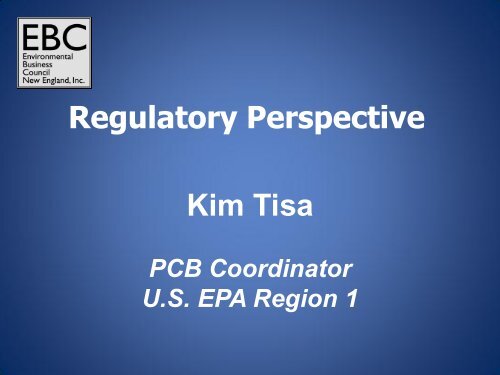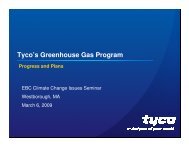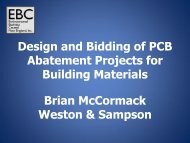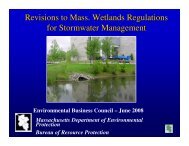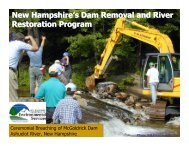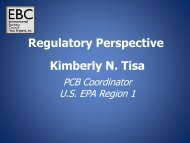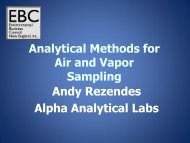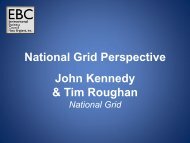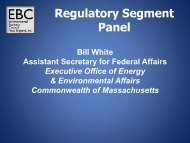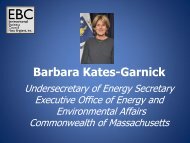Kim Tisa Regulatory Perspective
Kim Tisa Regulatory Perspective
Kim Tisa Regulatory Perspective
You also want an ePaper? Increase the reach of your titles
YUMPU automatically turns print PDFs into web optimized ePapers that Google loves.
<strong>Regulatory</strong> <strong>Perspective</strong><br />
<strong>Kim</strong> <strong>Tisa</strong><br />
PCB Coordinator<br />
U.S. EPA Region 1
PCBs in Building Materials<br />
<strong>Kim</strong> <strong>Tisa</strong>, PCB Coordinator<br />
US EPA Region 1
CURRENT REGULATIONS<br />
40 CFR Part 761<br />
Section 6(e) of the Toxic Substances Control Act<br />
of 1976 (TSCA) generally bans the manufacture,<br />
processing, distribution in commerce, and use of<br />
PCBs after 1978, but provides for exceptions<br />
based on an EPA finding of “no unreasonable<br />
risk of injury to health or the environment.”<br />
Most of the exceptions take the form of<br />
authorizations, which include conditions, such<br />
as location restrictions, repair restrictions, and<br />
concentration limits.<br />
1998 Amendments
<strong>Regulatory</strong> Considerations<br />
PCB regulations include owners and/or operators<br />
of PCB-contaminated property where the PCB<br />
contamination exceeds allowable concentrations<br />
under the regulations<br />
TSCA authority has not been delegated to any of<br />
the states, thus both EPA and state regulations<br />
will apply
Uses of Aroclor by Type<br />
Current Uses (since 1970) 1221 1232 1242 1248 1254 1260 1268<br />
Capacitors X X X<br />
Transformers X X<br />
Heat transfer<br />
X<br />
Hydraulic/lubricants<br />
Hydraulic fluids X X X X X<br />
Vacuum pumps X X<br />
Gas-transmission turbines X X<br />
Plasticizers<br />
Rubbers X X X X X X<br />
Synthetic resins X X X X<br />
Carbonless paper X X<br />
Miscellaneous<br />
Adhesives X X X X X X<br />
Wax extenders X X<br />
Dedusting agents X<br />
Inks X X<br />
Cutting oils X<br />
Pesticide extenders X<br />
<br />
Sealants and caulking<br />
compounds<br />
X
Issues<br />
<br />
The use of PCBs in non-liquid manufactured building products<br />
at >/= 50 ppm is prohibited under TSCA.<br />
<br />
Manufactured products containing PCBs have been found in<br />
many buildings and structures<br />
Caulk typically contains PCBs at very high levels - %<br />
<br />
The PCBs in the caulk migrate to a limited extent to<br />
surrounding materials (air, soil, masonry).<br />
<br />
Typical renovation procedures can increase exposures to<br />
workers and building residents, including children.
PCBs in Building Materials<br />
Bulk Product Waste (761.62)<br />
examples: caulk, applied dried paints, varnishes, other<br />
similar coatings or sealants, Galbestos<br />
Performance-based disposal<br />
Disposal in Solid Waste Landfill<br />
Risk-based Disposal Approval<br />
Daily Cover/Roadbed
Source Removal<br />
PCB Bulk Product Waste<br />
Caulk removal<br />
–Strip out<br />
Paint removal<br />
–Abrasives<br />
–Chemicals<br />
–Hydroblast<br />
**761.62**
Adjacent Surfaces<br />
PCB Remediation Waste<br />
Grind/cut out areas<br />
of contamination<br />
beyond “source<br />
material”<br />
Encapsulate porous<br />
surfaces<br />
Clean non-porous<br />
** 40 CFR 761.61 **
Management in Place<br />
Not acceptable for PCB bulk product<br />
waste (§ 761.62)<br />
May be acceptable for surrounding<br />
materials (§ 761.61)<br />
Possible short-term interim measure<br />
– Consultation with EPA<br />
– Sampling may be required
Excluded PCB Products<br />
Must meet all criteria under § 761.3<br />
May be left in place without further<br />
restrictions/requirements<br />
State Requirements may require<br />
removal
PROJECT CONSIDERATIONS
Establish DQOs<br />
DATA QUALITY<br />
Analytical program with adequate QA/QC<br />
samples is critical<br />
Laboratory Requirements<br />
– Extraction/Analytical Methods<br />
(3510, 3540C, 8082)<br />
– Reporting Limits
Activities to Date<br />
<br />
September 2009 (caulk guidance)<br />
– http://www.epa.gov/epawaste/hazard/tsd/pcbs (fact sheets,<br />
Q’s and A’s, and a Schools Information Kit)<br />
<br />
<br />
<br />
<br />
Steps to Safe Renovation and Abatement of Buildings that have PCB-<br />
Containing Caulk<br />
Developed public health levels for PCBs in indoor air for schools<br />
Conducting research on mitigation and exposures assessment on<br />
PCB sources in buildings (ORD)<br />
December 2010 (ballast guidance)<br />
– http://www.epa.gov/epawaste/hazard/tsd/pcbs
EPA Recommendations<br />
For buildings built between 1950 and 1978<br />
– Minimize exposure (e.g. ventilation, cleaning)<br />
– Take care when renovating<br />
– Take care when abating<br />
If you think you may have a problem<br />
– Test for elevated air levels<br />
– Test for source of air contamination<br />
Evaluate duct systems<br />
Sample deteriorating caulk
NEW CHANGES<br />
April 2010 ANPRM PCB Uses<br />
Federal Register Notice<br />
Vol. 77, No. 40<br />
Wednesday, February 29, 2012<br />
– Management of Demolition Debris<br />
30 day comment
Contacts and PCB Info<br />
<strong>Kim</strong>berly <strong>Tisa</strong> – USEPA Region 1 PCB<br />
Coordinator<br />
617-918-1527<br />
tisa.kimberly@epa.gov<br />
Caulk Hotline: 888-835-5372<br />
http://www.epa/gov/pcb<br />
http://www.epa.gov/region1/cleanup/pcbs<br />
/index.html


